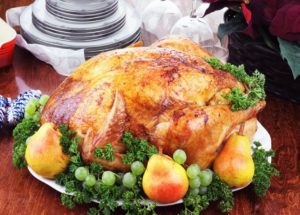
Sugar is an ingredient in beloved holiday foods from gingerbread houses to spiced punch. It’s easy to eat more sugar than one should when sampling all of the treats and delights you’ve come to associate with the holiday season. According to the World Health Organization, if you’re an adult eating more than 12 teaspoons of sugar per day during the holidays, you’re putting your teeth and body at risk.
Is sugar really so bad? How can holidays be the same without cookies, candy, and other sweets? Here’s what you should know.
Spice Is Nice but Sugar Is Naughty
Even though reducing your household’s sugar intake requires some changes, there are important reasons to limit your sugar consumption. Refined sugar intake is linked to many diseases including diabetes, heart disease, and cancer.
Sugar in the mouth will degrade teeth over time and increase plaque buildup on teeth and gums. If sugary foods are not brushed off and rinsed away soon after eating, they will put your mouth at risk of developing gum disease and cavities. Gum disease and cavities are not festive at all.
Use your research skills and imagination to add more spice and less sugar to your holiday tables and celebrations. By practicing healthy habits during the holidays, you keep your smile and your family bright and healthy for many holidays to come.
Kids Like Color and Fun
Your children associate treats with the season for many reasons. Holiday books, videos, and songs refer to sugarplums and candy canes. Grocery stores and bakeries display iced cookies and rich cakes. Friends and family create, buy, and deliver fudge and sweet breads to your kitchen.
Enhance the season without ruining the fun by using healthy foods to create memorable holiday traditions. Make a list of your most sugary food customs. Use your imagination and ideas from cookbooks and cooking websites to figure out new ingredients and serving methods.
These ideas and tips are a great way to start:
- Use cream cheese or hummus to coat the tops of tree-shaped pita wedges, then decorate with red and green bell peppers.
- Decorate a platter loaded with a tree-shaped layer of broccoli florets. Make “ornaments” of carrot disks, grape halves, cherry tomatoes, and cucumber slices.
- Slice the tops flat on strawberries, then turn them upside down. Pipe soft white cheese or low-sugar cream cheese icing all around the bottom edge to create a fruity Santa hat. Use icing to make a white puff at the top of each hat.
- Use metal cookie cutters to create stars, dreidels, and angels out of pineapple, watermelon, and other fruits and vegetables that have been sliced to between a half-inch and an inch thick.
If your children open many gifts over a period of time, or if they open a countdown calendar each day over the month, use holiday trinkets and healthy treats as gifts and calendar fillers rather than giving chocolates and hard candies. Monitor gifts given to kids by others to limit sugar intake when you aren’t looking.
Ancient Traditions Hold Healthy Magic
Embracing cultural holiday traditions is a tooth-healthy way to celebrate the season. Many traditional holiday dishes are full of wholesome ingredients. Ask older family members for ideas and recipes for main dishes, sides, and desserts. Some ideas you might adopt in your home include the following traditions:
Brazil
Many Brazilians enjoy fruit-basted turkey on their holiday menus. Roasted and baked poultry dishes with fruit are healthy foods for all ages. Cranberries sweetened with honey add tart sweetness and good nutrition to poultry dishes.
Italy
In this nation, diners enjoy the Feast of the Seven Fishes on Christmas Eve. Fish dishes are healthy and delicious when poached, stewed, or baked. Keep fried-fish dishes to a minimum due to breading which includes sugar.
West Africa
Traditions feature the sweet potato, pumpkin, plantain, peanuts, and black-eyed peas. Leave off the marshmallows when you create a sweet potato casserole. Make hearty stews of sweet potato and pumpkin.
Hungary
Hungarians make a lovely rolled cabbage filled with smoked ham which is healthy in moderation.
Puerto Rico
The island simmers with pots of sanchocho — a rich soup made of chicken and root vegetables. Vegetable soups are nutritious and healthy for the teeth.
Sweden
The Swedes display a table or “julbord” of dishes loaded with fish, ham, cheese, and beet salad. Beets, cabbage, brussel sprouts, and broccoli are beneficial side dishes.
South Korea
Pickled cabbage called “kimchi” and bean paste are eaten.
India
Indians celebrate Diwali, or the Festival of Lights, in late autumn. Special foods for Diwali include a stir-fried mix of 14 different greens and spices called chado shak.
If you’re not sure of your family’s past traditions or you simply want to sample cuisine from other cultures, go ahead and cook up some diverse holiday fare from another place or time. New taste sensations, smells, and holiday traditions with healthier foods can take your mind off the sugary holiday treats you’re avoiding.
Schedule a pre-holiday dental cleaning with Dr. Jerry F. Maymi & Associates to have a bright, white smile throughout the coming season.
